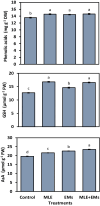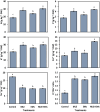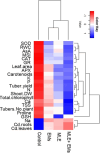Enhancing sweet potato (Ipomoea batatas) resilience grown in cadmium-contaminated saline soil: a synergistic approach using Moringa leaf extract and effective microorganisms application
- PMID: 38653894
- PMCID: PMC11133164
- DOI: 10.1007/s11356-024-33295-w
Enhancing sweet potato (Ipomoea batatas) resilience grown in cadmium-contaminated saline soil: a synergistic approach using Moringa leaf extract and effective microorganisms application
Abstract
Raising soil contamination with cadmium (Cd2+) and salinization necessitates the development of green approaches using bio-elicitors to ensure sustainable crop production and mitigate the detrimental health impacts. Two field trials were carried out to study the individual and combined effects of foliage spraying of Moringa leaf extract (MLE) and soil application of effective microorganisms (EMs) on the physio-biochemical, osmolytes, antioxidants, and performance of sweet potato grown in Cd2+-contaminated salty soil (Cd2+ = 17.42 mg kg-1 soil and soil salinity ECe = 7.42 dS m-1). Application of MLE, EMs, or MLE plus EMs significantly reduced the accumulation of Cd2+ in roots by 55.6%, 50.0%, or 68.1% and in leaves by 31.4%, 27.6%, or 38.0%, respectively, compared to the control. Co-application of MLE and EMs reduced Na+ concentration while substantially raising N, P, K+, and Ca2+ acquisition in the leaves. MLE and EMs-treated plants exhibited higher concentrations of total soluble sugar by 69.6%, free proline by 47.7%, total free amino acids by 29.0%, and protein by 125.7% compared to the control. The enzymatic (SOD, APX, GR, and CAT) and non-enzymatic (phenolic acids, GSH, and AsA) antioxidants increased in plants treated with MLE and/or EMs application. Applying MLE and/or EMs increased the leaf photosynthetic pigment contents, membrane stability, relative water content, water productivity, growth traits, and tuber yield of Cd2+ and salt-stressed sweet potato. Consequently, the integrative application of MLE and EMs achieved the best results exceeding the single treatments recommended in future application to sweet potato in saline soil contaminated with Cd2+.
Keywords: Biostimulants; Growth and productivity; Heavy metals; Osmoprotectants; Phytotoxicity; Salinity.
© 2024. The Author(s).
Conflict of interest statement
The authors declare no competing interests.
Figures







References
-
- Abalaka SE, Oyelowo FO, Akande MG, et al. Correction to: effects of Moringa oleifera leaves extract, vitamin C, and taurine co-exposures on calcium and metallothionein levels, oxidative stress, and gill histopathological changes in Clarias gariepinus exposed to sub-lethal cadmium. Environ Sci Pollut Res. 2022;29:40279. doi: 10.1007/s11356-022-20149-6. - DOI - PubMed
-
- Abd El-Mageed TA, El-Sherif AMA, Abd El-Mageed SA, Abdou NM. A novel compost alleviate drought stress for sugar beet production grown in Cd-contaminated saline soil. Agric Water Manag. 2019;226:105831. doi: 10.1016/j.agwat.2019.105831. - DOI
-
- Abd El-Mageed TA, Abdurrahman HA, El-Mageed SAA. Residual acidified biochar modulates growth, physiological responses, and water relations of maize (Zea mays) under heavy metal – contaminated irrigation water. Environ Sci Pollut Res. 2020;27:22956–22966. doi: 10.1007/s11356-020-08847-5. - DOI - PubMed
-
- Abd El-Mageed TA, Semida WM, Rady MM (2017) Moringa leaf extract as biostimulant improves water use efficiency, physio-biochemical attributes of squash plants under deficit irrigation. Agric Water Manag 193:. 10.1016/j.agwat.2017.08.004
MeSH terms
Substances
LinkOut - more resources
Full Text Sources
Miscellaneous

